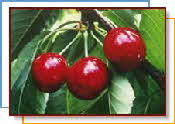FoodReference.com (since 1999)
COOKING TIPS AND HINTS SECTION
Home | Articles | Food Trivia | Today in Food History | Food Timeline | Recipes | COOKING_TIPS | Food Quotes | Who’s Who | Culinary Schools & Tours | Food_Trivia_Quizzes | Food Poems | Free Magazines | Food Festivals and Events
Cooking and Kitchen Tips and Hints, Measurements, Shopping Advice, Serving Ideas, etc.
See also: Article on Cherries
CHERRIES

Cherries should be stored at 35 degrees F. Keep away from cooler fans so they don’t dry out.
Be sure to rinse fresh cherries with plenty of water before eating them. Most cherries are sprayed with insecticides.
Cherries taste best if eaten at room temperature
Generally speaking darker color cherries are sweeter.
Excellent as dessert fruit, most sweet cherries found in the food store are produced in the Western States and are available from May through August. Red tart cherries, also called sour or pie cherries and used mainly in cooked desserts, have a softer flesh, lighter red color, and a tart flavor. They generally are shipped to processing plants and are sold frozen or canned.
Look for: A very dark color is your most important indication of good flavor and maturity in sweet cherries. Bing, Black Tartarian, Schmidt, Chapman, and Republican varieties should range from deep maroon or mahogany red to black for richest flavor. Lambert cherries should be dark red. Rainier cherries should be straw-colored. Good cherries have bright, glossy, plump-looking surfaces and fresh-looking stems.
Avoid: Overmature cherries lacking in flavor, indicated by shrivelling, dried stems, and a generally dull appearance. Decay is fairly common at times on sweet cherries, but because of the normal dark color, decayed areas are often inconspicuous. Soft, leaking flesh, brown discoloration, and mold growth are indications of decay.
COOKING TIPS
Please feel free to link to any pages of FoodReference.com from your website.
For permission to use any of this content please E-mail: james@foodreference.com
All contents are copyright © 1990 - 2025 James T. Ehler and www.FoodReference.com unless otherwise noted.
All rights reserved. You may copy and use portions of this website for non-commercial, personal use only.
Any other use of these materials without prior written authorization is not very nice and violates the copyright.
Please take the time to request permission.

